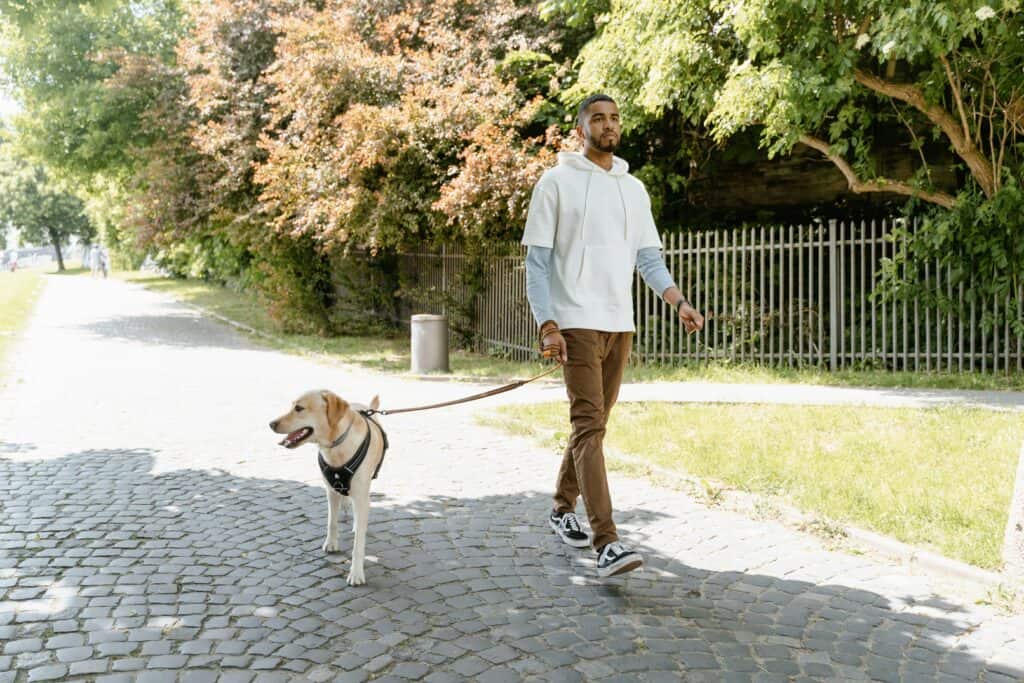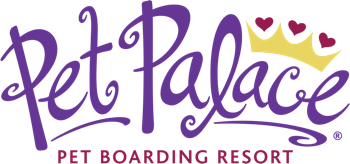5 Loose-Leash Dog Walking Tips
Posted by Lora Shaw on September 18, 2024

Loose-Leash Dog Walking Key Highlights
- Begin training in a distraction-free environment – Start loose-leash training indoors or in a quiet area to minimize distractions and help your dog focus. You can start introducing distractions inside the home to help train them as well. Once they get used to the idea, they will be ready for the outdoors.
- Practice turns and pace changes – Incorporate turns and vary your walking speed to teach your dog to pay attention to your movements and maintain alignment. Many unexpected things can occur on a walk, so you want your pup to be prepared.
- Understand canine body language – Learn to interpret your dog’s body language and sounds so you can effectively address and prevent unwanted behaviors during walks.
We all want our dogs on their best behavior, especially in public places. By teaching your dog to walk on a loose leash, you can feel confident stepping outside and create a more positive walking experience for both of you. With that being said, it might take some time for you pup to get used to the approach.
What Is Loose-Leash Dog Walking?
So what is loose-leash dog walking? It simply means that your dog is not pulling at all on your walk, but rather walking by your side. During a walking session, there should be no leash tension, the leash will be in a “J” shape, your dog will be trained not to sniff or mark constantly without a command word being said, and your dog will ignore distractions like noises, people, and other dogs.
The Importance of Teaching Your Dog to Walk on a Loose Leash
By teaching your dog to walk on a loose leash, you’ll be able to transform your walks into a highlight of the day for both you and your furry friend. Additionally, having your dog close and more controlled will make them safer. Teaching them the loose-leash skill will allow them to not be phased when encountering distractions like other dogs, cars, and more.
Tips on Training for Loose-Leash Dog Walking
As we mentioned above, this isn’t a skill that is acquired overnight. Since it might take some time for your pup to get used to, here are some tips that can help set you and your dog up for success:
- Start with a quiet environment – When training for loose-leash dog walking, you’ll want to do it in a place with minimal distractions. One tip is to start indoors first. That way there are no smells, noises, cars, people or dogs to take away your dog’s full attention.
- Practice turns – The goal is to walk in harmony and have your dog learn little signals so they know what will happen next (turning, stopping, etc.). Ideally, you will want to develop this communication so that you can easily navigate any turns or obstacles without having to verbalize them. Whether it’s signaling with your hands or turning with a corresponding foot, be consistent so your dog will start to pick up on your actions.
- Change pace – This is a good way to see if your dog is truly focusing only on you. This doesn’t only apply to walking, however, since if you’re a runner you will want your dog to be able to switch paces along with you.
- Understand your dog’s language – Since pets can’t speak, understanding their way of communicating will be key when teaching your dog to walk on a loose leash. This can be seen in both sounds and body language that you’ll want to familiarize yourself with. Ultimately, doing so is how you’ll learn to diffuse any unwanted behaviors you notice on walks.
- Teach the walking position with no leash – You may want to begin training your dog without a leash, as the leash itself can be a huge distraction for some dogs. As your dog catches up to you, mark when they are close and reward them with a high-value treat when by your side. If you constantly reward them in the same place, your dog will seek out this location as you continue your walk together. Once mastered, you can then introduce the leash.
The Benefits of Loose-Leash Walking
There are so many benefits to teaching your dog to walk on a loose leash. The first thing is improving your mental and physical health. Having a dog constantly pull on a walk can make things very stressful, leading to a feeling of dread every time a walk comes around, so teaching them this skill helps avoid that.
Another benefit is improving their behavior. As they develop the skill, they will gain better self-control and attentiveness, and you’ll also be able to take them to many more places since they are better behaved.
Another key benefit is that your relationship with your dog will be improved. Building communication with your dog will help you strengthen your bond with them and make them more motivated to please you. These skills benefit each of you both inside and outside the home, making for more successful interactions.
Products That Can Help
Loose-leash dog walking can be such a rewarding experience, but in order to get there you’ll need the right tools. Regardless of your dog’s age, having the following items on hand can make for a more enjoyable time:
- Clicker – These tools are great for indicating good behavior. Similar to saying the word “yes,” they give your dog a signal that they did what you wanted. Clickers can be easily bought online or from pet stores and they are very affordable.
- Treats – This should go without saying, but you’ll want to reward the good behavior your dog shows with treats they will enjoy. A big motivator is giving them high-value treats, so invest in some you can have on hand.
- Collars – You may come across e-collars or prong collars being used when teaching your dog to walk on a loose-leash. If you’re considering these, you might want to discuss what will best suit your dog with a professional trainer. You will also want to ensure that you use anything you choose properly so that your dog will be safe and your training will be effective.
- Treat pouch – Of course, if you’re bringing treats, you’ll need somewhere to store them. A treat pouch can come with a waist belt, which makes the treats easily accessible while training.
Interested in Dog Training? Check Out Pet Palace!
At Pet Palace, we want to bridge the communication gap between you and your dog with the help of positive reinforcement. Training is helpful regardless of the age of your dog and ultimately strengthens the bond between the two of you. Our puppy training at our Columbus location covers a wide range of lessons that can aid loose-leash dog walking, including:
- Bite inhibition
- Potty training
- Resource guarding
- Intro to touch
- Behavioral techniques
- Crate training
- Intro to sounds
- Basic commands
- Toy play
- Nutrition
- Intro to people
Our training is broken down into the following options:
- Polite Puppy Program – This is a 10-day course available to puppies eight months and younger. The program helps your pup learn basic obedience skills and how to socialize in a daycare setting.
- 10-Day Basic Adult Program – This is a 10-day course for dogs eight months and older. Here, they will spend each day doing one-on-one training with the trainer for the best results.
- 20-Day Advanced Adult Program – This program is a 4-week course available to dogs over eight months. This is a results-driven program, designed to give participants customizable and consistent training.
Are you ready to get started? Whether you need help teaching your dog to walk on a loose leash or want to work on something else, we’re ready to assist. If you’d like a trainer to contact you directly, fill out our training inquiry form. We can’t wait to meet your pup!

Categories: Dog Training, Dogs, Pet Safety, Tips for Your Pets
Archives
Recent Articles
Categories
Monthly Archive
- October 2025
- September 2025
- August 2025
- July 2025
- June 2025
- May 2025
- April 2025
- March 2025
- February 2025
- January 2025
- December 2024
- November 2024
- October 2024
- September 2024
- August 2024
- July 2024
- June 2024
- May 2024
- April 2024
- March 2024
- February 2024
- January 2024
- December 2023
- November 2023
- October 2023
- August 2023
- July 2023
- June 2023
- May 2023
- April 2023
- March 2023
- February 2023
- January 2023
- December 2022
- November 2022
- October 2022
- August 2022
- July 2022
- June 2022
- April 2022
- March 2022
- February 2022
- November 2021
- October 2021
- November 2020
- September 2020
- July 2020
- March 2020
- January 2020
- November 2019
- September 2019
- July 2019
- March 2019
- January 2019
- December 2018
- November 2018
- October 2018
- August 2018
- July 2018
- June 2018
- May 2018
- April 2018
- March 2018
- February 2018
- January 2018
- December 2017
- November 2017
- October 2017
- September 2017
- August 2017
- July 2017
- June 2017
- May 2017
- April 2017
- March 2017
- February 2017
- January 2017
- December 2016
- November 2016
- September 2016
- August 2016
- July 2016
- June 2016
- May 2016
- April 2016
- March 2016
- February 2016
- December 2015
- November 2015
- October 2015
- September 2015
- August 2015
- July 2015
- May 2015
- March 2015
- February 2015
- January 2015
- December 2014
- November 2014
- September 2014
- August 2014
- July 2014
- June 2014
- May 2014
- March 2014
- February 2014
- January 2014
- December 2013
- November 2013
- October 2013
- September 2013
- August 2013
- June 2013
- May 2013
- March 2013
